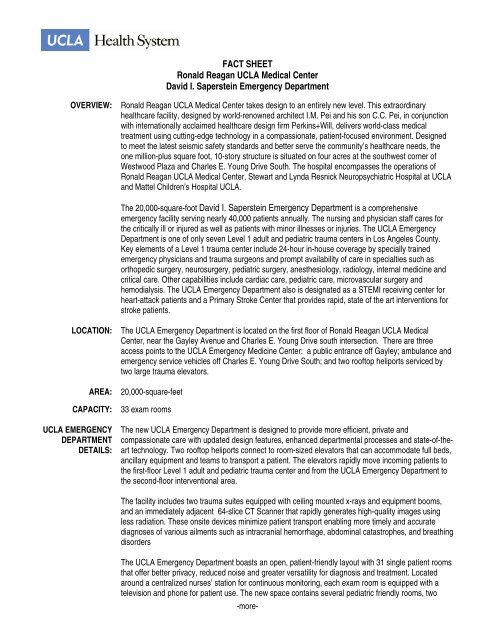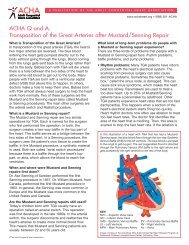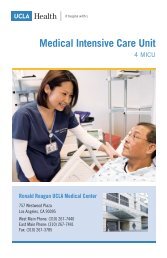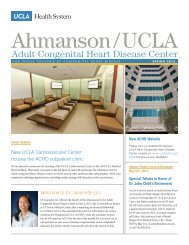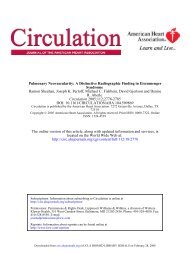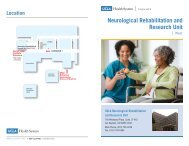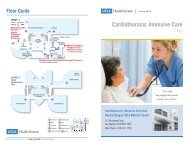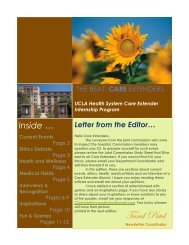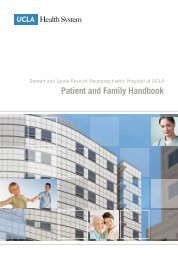FACT SHEET Ronald Reagan UCLA Medical Center David I ...
FACT SHEET Ronald Reagan UCLA Medical Center David I ...
FACT SHEET Ronald Reagan UCLA Medical Center David I ...
Create successful ePaper yourself
Turn your PDF publications into a flip-book with our unique Google optimized e-Paper software.
<strong>FACT</strong> <strong>SHEET</strong><br />
<strong>Ronald</strong> <strong>Reagan</strong> <strong>UCLA</strong> <strong>Medical</strong> <strong>Center</strong><br />
<strong>David</strong> I. Saperstein Emergency Department<br />
OVERVIEW:<br />
<strong>Ronald</strong> <strong>Reagan</strong> <strong>UCLA</strong> <strong>Medical</strong> <strong>Center</strong> takes design to an entirely new level. This extraordinary<br />
healthcare facility, designed by world-renowned architect I.M. Pei and his son C.C. Pei, in conjunction<br />
with internationally acclaimed healthcare design firm Perkins+Will, delivers world-class medical<br />
treatment using cutting-edge technology in a compassionate, patient-focused environment. Designed<br />
to meet the latest seismic safety standards and better serve the community’s healthcare needs, the<br />
one million-plus square foot, 10-story structure is situated on four acres at the southwest corner of<br />
Westwood Plaza and Charles E. Young Drive South. The hospital encompasses the operations of<br />
<strong>Ronald</strong> <strong>Reagan</strong> <strong>UCLA</strong> <strong>Medical</strong> <strong>Center</strong>, Stewart and Lynda Resnick Neuropsychiatric Hospital at <strong>UCLA</strong><br />
and Mattel Children’s Hospital <strong>UCLA</strong>.<br />
The 20,000-square-foot <strong>David</strong> I. Saperstein Emergency Department is a comprehensive<br />
emergency facility serving nearly 40,000 patients annually. The nursing and physician staff cares for<br />
the critically ill or injured as well as patients with minor illnesses or injuries. The <strong>UCLA</strong> Emergency<br />
Department is one of only seven Level 1 adult and pediatric trauma centers in Los Angeles County.<br />
Key elements of a Level 1 trauma center include 24-hour in-house coverage by specially trained<br />
emergency physicians and trauma surgeons and prompt availability of care in specialties such as<br />
orthopedic surgery, neurosurgery, pediatric surgery, anesthesiology, radiology, internal medicine and<br />
critical care. Other capabilities include cardiac care, pediatric care, microvascular surgery and<br />
hemodialysis. The <strong>UCLA</strong> Emergency Department also is designated as a STEMI receiving center for<br />
heart-attack patients and a Primary Stroke <strong>Center</strong> that provides rapid, state of the art interventions for<br />
stroke patients.<br />
LOCATION:<br />
AREA:<br />
CAPACITY:<br />
<strong>UCLA</strong> EMERGENCY<br />
DEPARTMENT<br />
DETAILS:<br />
The <strong>UCLA</strong> Emergency Department is located on the first floor of <strong>Ronald</strong> <strong>Reagan</strong> <strong>UCLA</strong> <strong>Medical</strong><br />
<strong>Center</strong>, near the Gayley Avenue and Charles E. Young Drive south intersection. There are three<br />
access points to the <strong>UCLA</strong> Emergency Medicine <strong>Center</strong>: a public entrance off Gayley; ambulance and<br />
emergency service vehicles off Charles E. Young Drive South; and two rooftop heliports serviced by<br />
two large trauma elevators.<br />
20,000-square-feet<br />
33 exam rooms<br />
The new <strong>UCLA</strong> Emergency Department is designed to provide more efficient, private and<br />
compassionate care with updated design features, enhanced departmental processes and state-of-theart<br />
technology. Two rooftop heliports connect to room-sized elevators that can accommodate full beds,<br />
ancillary equipment and teams to transport a patient. The elevators rapidly move incoming patients to<br />
the first-floor Level 1 adult and pediatric trauma center and from the <strong>UCLA</strong> Emergency Department to<br />
the second-floor interventional area.<br />
The facility includes two trauma suites equipped with ceiling mounted x-rays and equipment booms,<br />
and an immediately adjacent 64-slice CT Scanner that rapidly generates high-quality images using<br />
less radiation. These onsite devices minimize patient transport enabling more timely and accurate<br />
diagnoses of various ailments such as intracranial hemorrhage, abdominal catastrophes, and breathing<br />
disorders<br />
The <strong>UCLA</strong> Emergency Department boasts an open, patient-friendly layout with 31 single patient rooms<br />
that offer better privacy, reduced noise and greater versatility for diagnosis and treatment. Located<br />
around a centralized nurses’ station for continuous monitoring, each exam room is equipped with a<br />
television and phone for patient use. The new space contains several pediatric friendly rooms, two<br />
-more-
<strong>FACT</strong> <strong>SHEET</strong>: <strong>UCLA</strong> Emergency Department – 2<br />
triage rooms, multiple trauma bays, a designated low acuity patient care area and a psychiatric care<br />
suite.<br />
A concierge greets patients entering the facility and establishes an initial point of contact. Located on<br />
the ground level of <strong>Ronald</strong> <strong>Reagan</strong> <strong>UCLA</strong> <strong>Medical</strong> <strong>Center</strong>, the <strong>UCLA</strong> Emergency Department’s waiting<br />
area enjoys natural light and a sense of plentiful space through large windows that overlook<br />
surrounding gardens, green spaces and gathering places. A designated pediatrics waiting area<br />
features a TV and child-friendly activities. The adult waiting area is separated into high and low acuity<br />
areas to increase patient satisfaction while waiting for treatment.<br />
ADJACENT<br />
DEPARTMENTS:<br />
Diagnostic Radiology Department: Adjacent to the <strong>UCLA</strong> Emergency Department, the Diagnostic<br />
Radiology Department includes two magnetic resonance imaging (MRI), three computed tomographic<br />
(CT) scanners, four Direct Radiography and two Rad/fluoro suites. The Interventional Radiology<br />
Department is located on the second floor and is quickly accessed via two trauma elevators or four<br />
gurney-sized elevators.<br />
Interventional Imaging Suite: The imaging suite contains the latest imaging platforms that support all<br />
interventional diagnostic and treatment functions. Two units are devoted to 3-D neuroangiography;<br />
three to vascular angiography; and one to CT (computed tomography) scanning for biopsy procedures,<br />
as well as to guide ablation and injection procedures. <strong>UCLA</strong> is among the first in the country with a new<br />
dual-source 64-detector CT. It incorporates two X-ray sources and two 64-row detectors in a single<br />
scanner, enabling physicians to rapidly capture high-quality images using less radiation. With state-ofthe-art<br />
technological capacity, the neuroangiography and interventional MRI units form the core of the<br />
<strong>UCLA</strong> Stroke <strong>Center</strong>.<br />
LEADERSHIP:<br />
Dr. Marshall Morgan, Chief of Emergency Medicine, <strong>Ronald</strong> <strong>Reagan</strong> <strong>UCLA</strong> <strong>Medical</strong> <strong>Center</strong><br />
Dr. Lynne McCullough, <strong>Medical</strong> Director, <strong>UCLA</strong> Emergency Department, <strong>Ronald</strong> <strong>Reagan</strong> <strong>UCLA</strong><br />
<strong>Medical</strong> <strong>Center</strong><br />
Johanna Bruner, MS, RN, FNP, Director Emergency Department, <strong>UCLA</strong> Emergency Department;<br />
Director, Cardiology Services, <strong>Ronald</strong> <strong>Reagan</strong> <strong>UCLA</strong> <strong>Medical</strong> <strong>Center</strong>


